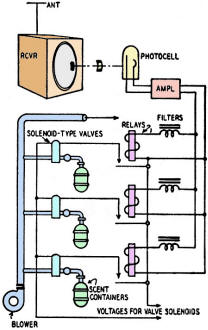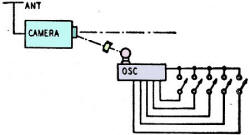|
June 1951 Radio-Electronics
 [Table of Contents] [Table of Contents]
Wax nostalgic about and learn from the history of early electronics.
See articles from Radio-Electronics,
published 1930-1988. All copyrights hereby acknowledged.
|
We all know that for the most
part television stinks. Back in 1951 when this article appeared in Radio-Electronics
magazine, the technology was very new and it was considered a miracle not to be
wasted on inane programming. Newscasts actually presented news and not opinion,
movies and sitcoms cast the nuclear family, law enforcement, the military,
religion, and patriotism in a positive light rather than as the purveyors of evil
in the world. By the end of the 1960s to early 1970s a lot of that had changed.
Political and social agendas weaseled their way into nearly all programming to the
extent that terms like "boob tube" and even, yes, "smellivision," became common
monikers for television. The form of smellivision presented in this article
was granted patent (US2540144A)
protection in 1951 under the title, "Television with scent effects." It did not
claim to transmit actual scents, but rather a series of signals that triggered the
release of certain scents at the receiver end which were blown into the viewer area.
A conspicuous absence of such a system in today's world of technology is evidence
of the concept's lack of practicality. Scratch-and-sniff TV screens didn't fare
too well, either.
Smellevision Now Here!

Fig. 2 - Smellivision receiver.

Fig. 1 - Smellivision transmitter.
Inventors have sought at different times and in various ways to add the illusion
of scent to the arts of the theater. Scents actually have been released among the
audience in experimentally produced plays, with some success, but apparently never
enough to make scent effects a regular part of the theater. Patents have even been
taken out for scent devices for use with motion pictures.
It remained to New York inventor Emery I. Stern to add scent effects to television.
The idea no doubt was suggested by friends' remarks about some of the current programs.
The theory of his invention is simple. As shown in Fig. 1, an oscillator supplies
a lamp with current modulated at a frequency controlled by the switches connected
to the oscillator. The lamp throws a beam on a corner of the iconoscope, making
a modulated pattern there which is presented in the same corner of the receiving
kinescope. It is a comparatively simple matter to detect the signal with a photocell
(Fig. 2) and use each frequency to trip its own relay, releasing the appropriate
odor into the blower system, which appears quite adequate to spread the smell through
the average living room. The scents of course are kept under pressure so that as
soon as each valve is opened by its relay the odor will gush out into the blower
tube.
More elaborate methods for diffusing the scents would be used in auditoriums.
The heating or cooling system of the auditorium might be used to cause air currents
of the correct temperature and speed. The appropriate scent mixture would then be
added to the air as it enters the room. It would also be very important that the
scent be mixed with the air in the proper proportions, so that it is strong enough
for all in the auditorium to smell it, yet not too strong to spoil the desired effect.
How many of the containers will be necessary and what scents are considered the
most useful on a television program are matters not mentioned in the patent, which
is No. 2,540,144.
Posted May 25, 2020
|





























